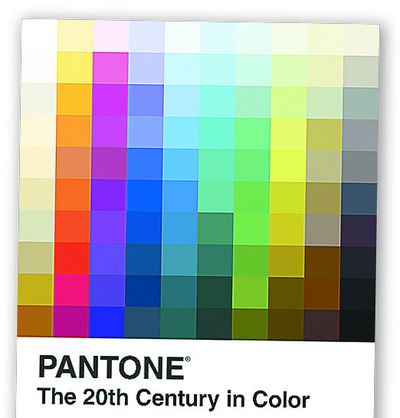Book explores intersection of color and cultural history

Why was Parrish blue the “in” color of the 1910s? What was with those 1950s pink bathrooms? Remember the 1970s’ “Harvest Gold” kitchen appliances?
A new book, “Pantone: The 20th Century in Color” (Chronicle Books), looks at how color and cultural history affect each other, and find their way into our homes.
Authors Leatrice Eiseman and Keith Recker are consultants for Pantone, the New Jersey-based company that developed a standardized color system used by designers, manufacturers, printers and publishers. They use a curatorial approach in discussing each decade’s most prevalent colors and why they might have become popular.
It’s an unusual lens on the last century: What was happening in society literally colored our lives, through upholstery, wall paint, rugs, and other textiles and accessories.
The authors begin with the 1900s and the Edwardian era, what they call “the last good time of the upper classes.” Coronations in several European countries were celebrated by craftsmen like Cartier, Faberge, Lalique and Tiffany with beautiful objects, whose colors – violet, emerald and gold – were embraced by the public.
The Arts and Crafts movement was the counterpoint to all that, with simpler patterns and more restrained yet complex colors: deep Brittany blue, antique white, leather and loden.
Artist Maxfield Parrish, known for fanciful magazine, book and advertising illustrations, popularized an intense cobalt hue. And when Les Ballets Russes debuted to rave reviews, it inspired a craze for Eastern pattern and color – deep turquoise, navy, claret and amber.
Picasso and the Cubists used charcoal, chocolate and pops of vermillion. But when fashion designer and Orientalist Paul Poiret started dressing women in shell pink and soft gray kimonos, that airier palette, anchored with black and metallics, became the hallmark of Art Nouveau decor.
After the turmoil of World War I, strong, comforting and familiar colors like cashew, cream, true blue and lichen were favorites for both the exterior and interior of homes.
“The vibrancy of the colors of 1920s fabrics surprised me – I was amazed at the intensity,” Eiseman said in an interview. During that decade of exuberance and experimentation, Art Deco featured black and white, the seductive Jazz Age berry and grape hues, and the gold, henna and Nile blue that came in vogue after the discovery of King Tut’s tomb ignited a craze for Egypt.
During the Depression, films offered escapist glamour; French designers such as Chanel and Lanvin dressed the stars in luxurious fabrics, furs and jewels, so colors like pearl, ebony and copper were the rage.
But there was also the Parks and Recreation movement, spearheaded by President Roosevelt. Artists created posters, sculptures and other works to help promote new parks and public buildings. It’s Eiseman’s favorite decade.
“Ultimately the careers of many impoverished artists, Rothko and Pollock among them, were literally nourished during that period,” she said.
The palette? Naturalistic tones like olive, amber and azure.
And then came plastic. With the invention of synthetic resins, wonderfully vivid shades of yellow, reddish orange, emerald and purple were used in all sorts of household goods from radios to utensils.
The notion that color affects our moods and energy took off in the 1940s. Pittsburgh Paints put out “color dynamic” brochures and ads espousing the uplifting effects of hues like apricot, meadow, vanilla and smoky rose.
When the war ended, people were ready to party, and filled their lives with the upbeat colors of Frisbees and Hawaiian shirts: bright blue, lava and yellow.
These hues drifted into the early 1950s – think Fiesta ware, Revlon red lipstick, a turquoise Studebaker. The era brings to mind youthful optimism, and color reflected that. Mamie Eisenhower’s favorite hue was pink; she filled rooms in the White House with the color, and soon homes across America followed suit.
But cute wasn’t the only dynamic in play. The sophisticated, organic hues of Eames’ midcentury design – mustard, eggplant, melon – also found an audience.
In the 1960s, psychedelic fuchsia, lime and taxi yellow, as well as pepper green, saffron and soft peach, reflected both pop culture and the influence of The Beatles’ India trip.
“If the ’60s were a party, the ’70s were a therapy session,” write Eiseman and Recker. Earthy, contemplative colors reflected a new interest in ecology and nature. That explains the Avocado Green stove and Harvest Gold fridge.
The 1970s was a style smorgasbord, with disco, French country and California surf culture contributing color stories of their own, from neon to lavender and periwinkle to taupe and sand.
Prep style and Miami Vice made pink, green, khaki and aqua hot in the ’80s. Yves Saint Laurent’s Moroccan-themed collection used saffron and violet. But the decade also flirted with Japanese style, and its palette of gray, carmine and chartreuse. Artist Keith Haring’s spirited graffiti art, in his three favorite colors – black, white and red – became a trend.
The ’90s, to Eiseman and Recker, evoke grunge – muddy graphite, hazy purple, faded denim – as well as spa culture, blingy metallics a la Versace and Gucci, and Latin American colors.